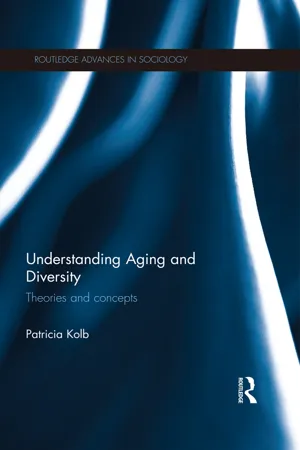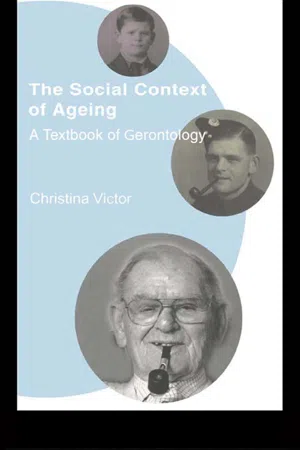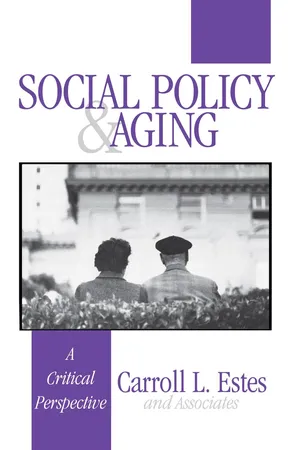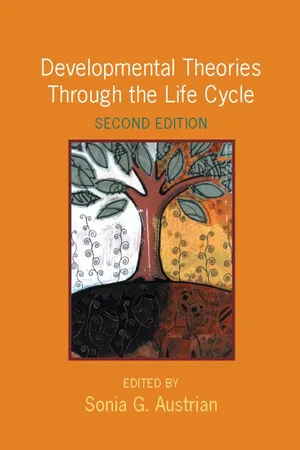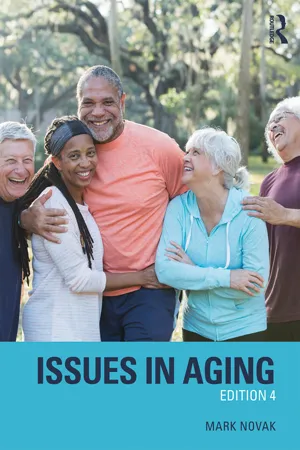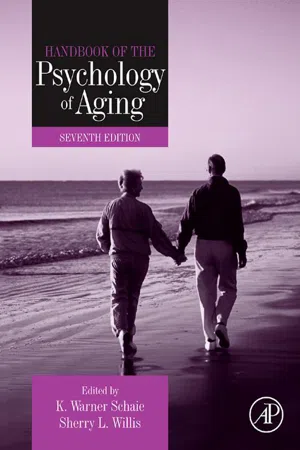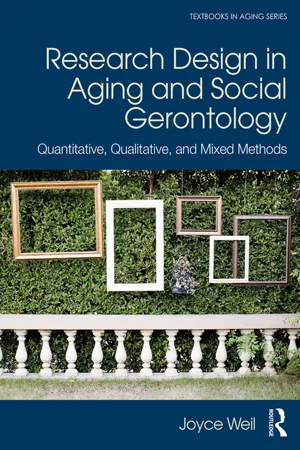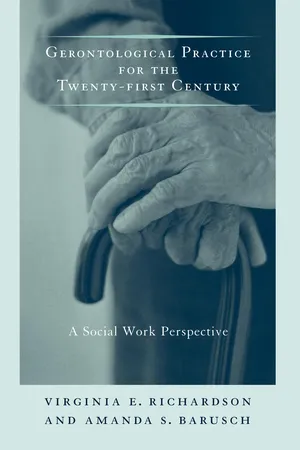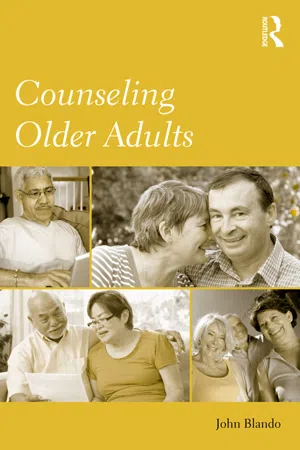Social Sciences
Theories of Aging
Theories of aging are frameworks that seek to explain the processes and factors that contribute to the aging of individuals. These theories encompass biological, psychological, and sociological perspectives, and they aim to understand the complexities of aging from multiple angles. Key theories include the programmed aging theory, the damage or error theory, and the sociological theory of aging, each offering unique insights into the aging process.
Written by Perlego with AI-assistance
Related key terms
11 Key excerpts on "Theories of Aging"
- eBook - ePub
Understanding Aging and Diversity
Theories and Concepts
- Patricia Kolb(Author)
- 2014(Publication Date)
- Routledge(Publisher)
2 Development of gerontology and sociological Theories of AgingKey concepts
1. Old age has been a topic of study and reflection for thousands of years, but changing social environments, individual and group experiences require continued exploration.2. Since 1960, research and education about social and behavioral aspects of aging have burgeoned in the new discipline of gerontology and in anthropology, economics, social history, sociology, cognitive and developmental psychologies, and social work.3. Social aging refers to the nature of the society in which aging occurs, the influence that society has on its aging individuals, and the impact aging individuals have on their society.4. Many social gerontological theories exist, but there are conflicts about the lack of a general theory that can become an organizing framework for understanding and explaining aging.5. Differences among and within social science fields contribute to controversies about approaches for developing gerontological knowledge, but concepts in diverse approaches are the building blocks of theory although objectives and methods are different.6. Interests of social gerontologists that are of particular interest to sociologists include, but are not limited to, the process of creation and change in social organizations as they respond to age-related experiences associated with birth, socialization, role transitions, retirement, and death.7. - eBook - ePub
The Social Context of Ageing
A Textbook of Gerontology
- Christina Victor(Author)
- 2004(Publication Date)
- Routledge(Publisher)
In the United Kingdom in particular this framework has had a profound influence upon the study of ageing and in generating knowledge about the social context of ageing. The emphasis upon the 'problems' of ageing means that our knowledge and understanding of other non-problematic dimensions of ageing remains sparse. This type of framework can also be seen in the priority areas identified for research by bodies such as the Economic and Social Research Council (ESRC) and the Medical Research Council (MRC) who are concerned with the potential 'future burden' of health and illness among older people and advances a research agenda that is concerned with such matters. The ESRC Growing Older programme also demonstrated a concern with many of the perceived 'problematic' dimensions of growing older and has a heavily social policy focus. There remains little interest from funding bodies or research organisations in the 'everyday life' of older people nor in the study of problems identified by older people rather than policy makers (Gubrium and Holstein, 2000; Bytheway, 2003).Developing theory in social gerontology
There are a number of different explicit theoretical frameworks concerned with the study of ageing. Psychological and physiological perspectives upon ageing focus upon the changes which happen to individuals. However, when focusing upon the social context within which ageing occurs, both for groups and individuals, then theories derived from sociological perspectives are most pertinent. As noted earlier, a concern with examining and understanding the social context of ageing involves studies which look at questions concerned with the adaptation of individuals (a microscale approach) and of questions posed at the macroscale (i.e. concerns with the impact of ageing upon social structures and vice versa). Social theories of ageing are characterised both by the level of explanation at which they operate and by the assumptions and ideologies that underpin them. Aroni and Minichiello (1992) developed a typology of theories including both the level of analysis (micro versus macro theories) and nature (interpretist contrasted with normative theories such as role theory). When evaluating the theories summarised below, and when encountering others not covered here, the student of gerontology needs to consider four basic questions: What is the level of explanation at which theory x - eBook - ePub
Social Policy and Aging
A Critical Perspective
- Carroll L. Estes(Author)
- 2001(Publication Date)
- SAGE Publications, Inc(Publisher)
Since its inception in 1945, the field of gerontology has evolved into a formal interdisciplinary science involving biology, clinical medicine, and the behavioral and social sciences. Although researchers, practitioners, and the general public agree that aging is a part of the life course, there has been substantial disagreement among and within these groups regarding the definition of old age, the perception of what constitutes normal aging, and the extent and scope of public/private responsibility for optimal, successful, or productive aging. This disparity in perspectives is reflected in the broad and fragmented body of theory that constitutes the field of gerontology where “there is no common thread or tie to a common core of disciplinary knowledge to unify the field” (Estes, Binney, & Culbertson, 1992, p. 50).One dimension of this fragmented body of work on aging stems from the larger social science debate between “micro” versus “macro” perspectives in which the leading Theories of Aging emphasize either the individual actor or the structure of society as the primary object of study. A small number of theoretical strands attempt to link both micro-perspectives and macroperspectives (Bengtson, Burgess, & Parrott, 1997; Marshall, 1996). Newer efforts have attempted also to integrate the mesoperspective (Estes, 1998b). Another classification dimension of different gerontological theories (also consistent with the larger disciplinary social sciences) is the “normative” versus the “interpretive” perspective (Hendricks, 1992; Marshall, 1996). A third classification dimension that may be contrasted with the previous two is the “critical,” or “radical,” perspective.Many of the leading Theories of Aging, especially those that approach the study of aging from the perspectives of biology and social psychology, focus on the individual as the primary unit of analysis. In the early work (1945 to the 1980s), the aging process was most often viewed and assessed in terms of the biological breakdown of the individual, or in terms of the individual personality and process, and the presumed concomitant dependency, loss, and requisite adjustment to these states of being.Disengagement TheoryThe “first generation” of gerontological theories (Bengtson et al., 1997; Hendricks, 1992) developed by social psychologists focused on the individual, culminating in disengagement theory and activity theory. Disengagement theory (Cumming & Henry, 1961) posits that old age is a period in which the aging individual and society both simultaneously engage in mutual separation (e.g., retirement and disengagement from the workforce). The process of disengagement is treated as a natural, universal, biologically based, and normal part of the life course. This assertion also fits into the broader functionalist paradigm that was dominant at the time of its development (late 1950s-late 1960s) in which disengagement was presumed to be “functional” from the standpoints of both the individual and society. Although disengagement theory is no longer widely accepted among researchers in aging, its influence is still apparent in the policy arena. Social Security and Medicare as well as the retirement policies in the private sector are all policies based in an acceptance of disengagement theory. In fact, disengagement theory provides a theoretical rationale for the trend in implementing incentives for early retirement in private and public sector institutions that have been promoted over the past several decades. - eBook - ePub
- Sonia Austrian(Author)
- 2008(Publication Date)
- Columbia University Press(Publisher)
In contrast, Moody (1988) wrote that it is impossible to develop an overarching “theory of aging,” because aging is inherently multidimensional. Observing that people are multifaceted biological, psychological, social, and spiritual beings, he said that a single theory of aging is unlikely to include all these areas. Moody considers one of the most serious problems in gerontology to be the question of the relationship between different levels or domains of theory, but he has suggested that it is incorrect to assume that the problem of theory construction can be adequately addressed by “a positivist presumption of a ‘unified science’” (1988:20). A more humanistic and self-reflexive approach to social gerontology is necessary to address the fragmentation of empirical work, the lack of self-criticism, and the need for a broader historical understanding of social theory and political advocacy. He supported the use of the humanities and social sciences as resources for constructing Theories of Aging that correspond to fundamental ideas of time, narrative, and development over the life course. Moody recommended that critical theory, as developed by Jurgen Habermas and other sociologists of the Frankfurt School, be used in the development of a more humanistic and self-reflexive approach to social gerontology (Moody 1988:19–20).Neugarten (1996a:58–59) has suggested that for “the anthropologist and the sociologist, age is a major dimension of social organization. To the psychologist, it is a major dimension by which the individual organizes his life course and interprets his life experience.” Birren and Lanum (1991:113) suggested that the psychology of aging “must describe how behavior comes to be organized, how it changes over the adult years, and the conditions under which it becomes disorganized.” The compartmentalization of subspecialties within psychology has contributed to diverse perspectives on aging; “on one extreme, aging is viewed as the unfolding of a predetermined pattern of changes dictated by the genome that is universal and characteristic of the species. At the other extreme, the adult organism is seen as a product of random events which retains plasticity and potential” (1991:115, 126). Components or contributions from biology, psychology, and the social sciences are necessary in the psychology of aging, but “the past metaphors of psychology do not readily promote an ecological point of view of an evolved species interacting with a social and physical environment to result in different pathways characteristic of old age” (Birren and Lanum 1991:126). - eBook - ePub
Decoding the Cultural Stereotypes About Aging
New Perspectives on Aging Talk and Aging Issues
- Evelyn M. O'Reilly(Author)
- 2013(Publication Date)
- Routledge(Publisher)
IILiterature Review and Theoretical FrameworkGrowing old is inevitable! The biological process of aging is the slow but continuous changes that occur between birth and death, that seem to be a feature of human life in all cultures.There is nothing to prepare you for the experience of growing old. Living is a process, an irreversible progression toward old age and eventual death. You see men of eighty still vital and straight as oaks; you see men of fifty reduced to gray shadows in the human landscape. The cellular clock differs for each one of us, and is profoundly affected by our own life experiences, our heredity, and perhaps most important, by the concepts of aging encountered in society and in oneself. (Curtin, 1972, p. 113)Although everyone grows older, the particular ways individuals age and the meanings they attach to the life course are not universal. Also the way the life course is divided including the markers that delineate old age is highly variable. Our own cultural conceptions of age and aging are just that: our own. (Foner, 1984 , p. 1)Riley (1978) explained that the themes of aging may mold "personal plans, hopes and fears," (p. 2) as well as influence the way individuals in different cultures age. In fact they may effect the values associated with life and death.This thesis reviews several areas of theory. The search included: (a) Literature on aging, which constitutes one area of information; (b) cultures, that is a people's way of living; (c) communication theory, which is what occurs when people interact or gather together in any situation; and (d) finally a glimpse at the social patterns of retirement. I decided to begin with a history of aging. As Chudacoff (1989) tells us, we live in an age conscious society and:Every person has an age; it is a direct, objective measure of the duration that someone has lived. Though we sometimes try to alter or distort age, it is an inescapable attribute of life; ultimately we cannot change or manipulate it as we change our weight, hair color or even sex. But in the past century or so, age has come to represent more than a chronological, biological phenomenon. It has acquired social meaning, affecting attitudes, behavior, and the ways in which individuals relate to each other, (p. 4) - eBook - ePub
- Anita Atwal, Ann McIntyre(Authors)
- 2013(Publication Date)
- Wiley-Blackwell(Publisher)
Differences in activity and participation also occur between men and women, and especially the types of activities that men and women benefit from. Although both men and women benefit from participating in leisure activities, women seem to benefit more from these. Whereas older women benefit from leisure activities involving social engagement, men benefit more from solitary interests and hobbies (Agahi and Parker 2008). Therefore, it is important to consider the individual preferences of older people when providing them with interventions, especially group-based sessions.There are also contrasting socio-cultural expectations and opportunities for men and women around the world. Women may have had more restrictions in education, employment, access to healthcare, legal, financial and social support during their lifespan which would impact on their experiences of older age (WHO 2003).Theories of ageing
From the previous sections in this chapter, it is evident that as a practising occupational therapist, one needs to be aware of differing perceptions and definitions of old age as well as individual beliefs and attitudes. It is also important to consider different theories of how and why we age, so that our practice promotes occupational justice, and optimal health and wellbeing. Although many people would like to deny that ageing occurs, it is necessary to remind ourselves that ageing is inevitable and a lifelong process. Indeed, our health and social behaviours in early life will often predetermine how well or successful our old age becomes. Whereas some theories of ageing focus on the concept of longevity, others promote living longer with better health, wellbeing and quality of life. It is also important to understand how and why we age so that we can distinguish between normal ageing and pathological processes caused by a health condition; these are considered more fully in Chapters 6 and 7 where ageing of body functions and structures is discussed. In this section we will consider biological, psycho-social and bio-psycho-social theories of ageing.Biological theories of ageing
Even though the maximum lifespan for humans has not changed radically over the centuries, the average life expectancy has increased in the industrialised world. There are many biological theories of ageing which seek to explore the rationale for both the maximum and average lifespan; however, no single theory fully explains the ageing process in humans. Biological ageing has its basis in cellular and sub-cellular change with many researchers hypothesising how and why cells die and whether cell death can be prevented or slowed. - eBook - ePub
- Mark Novak(Author)
- 2018(Publication Date)
- Routledge(Publisher)
Social gerontology makes up a part of the total body of gerontological knowledge. It includes the psychosocial, socioeconomic-environmental, and practice-related studies of aging. Clark Tibbitts first introduced the idea of social gerontology in 1954. Social gerontology views aging from the perspective of the individual and the social system. When social gerontologists look at biomedical issues, they focus on the social effects of physical aging. For example, they ask how changes in a person’s ability to walk affect that person’s needs for social services. Or they ask how physical aging differs by race and ethnicity. Do older African Americans and whites have the same diseases at the same rates and from the same causes? Social gerontologists also look at changes throughout the life course. They study changes in family life, relationships, and activities. Social gerontology has grown in importance in the past 20 years.Key Termssocial gerontology makes up a part of the total body of gerontological knowledge. It includes the psychosocial, socioeconomic-environmental, and practice-related studies of aging.theory is a “conceptual model of some aspect of life” (Online Dictionary, 2004).Theories of Aging
My grandmother used to keep her eyeglasses pushed up onto her head. I remember one day watching her walk around the house with a puzzled look on her face.“Grandma,” I asked, “what are you looking for?” “My glasses. I can’t find them anywhere.” “They’re on your head,” I said with a laugh. “Oh,” she said, as she patted her head. “I must be getting old.”In that moment my grandmother expressed a theory of aging: when you get old, you forget things, such as where you put your eyeglasses. She didn’t think of this as a theory; she didn’t know anything about theories. But she had one. When she forgot where she put her glasses, it confirmed her belief that you forget things when you age.Many psychologists use this same theory in their research. They suspect that memory declines with age, and they have produced volumes of literature to test this theory. In this way researchers differ from my grandmother. They suspect that memory decreases with age, but they try to prove or disprove this idea. - eBook - ePub
- K Warner Schaie, Sherry L. Willis(Authors)
- 2010(Publication Date)
- Academic Press(Publisher)
Handbook series. Six historically valid, recurring themes or lessons are identified, each of which provides points of contact across developmental processes, theoretical perspectives, and historical periods. Subsequently, I briefly adumbrate several other recent contributions to the literature on theories of psychological aging with attention to the six enduring themes previously identified. Third, these coordinated perspectives and enduring themes provide a foundation upon which to evaluate current theoretical efforts and evolve new and more adaptive ones. Fourth, compelling opportunities for new theoretical advances in psychological aging are provided by new developments in neighboring disciplines, a selection of which are noted in this section. The general goal of this chapter is not one of producing a global or unified theory of psychological aging. Instead, it aims to (a) explain why such a goal may not be among the principal standards or objectives for researchers in this field, and (b) support the contention that theoretical opportunities and advances based on a population of adapted themes and theories are nevertheless plentiful, functional, and promising.Characterizing the Theoretical Landscape in Psychological Aging
Just as no history of a science is without the influence of the historian and his or her historiography, no review of scientific theory exists independently of the filtering lens through which the theorists read, interpret, and write (Hanson, 1958 ) or the historically evolving conceptual, social, professional, and scientific circumstances of the era (e.g., Kuhn, 1962 ; Pepper, 1970 ; Toulmin, 1972 ). In the past in life-span psychological research, such observations have often led to discussion of scientific paradigms, metatheories, and world views, as they applied to the study of individual development and aging (e.g., Baltes & Willis, 1977 ; Dixon & Lerner, 1999 ; Reese & Overton, 1970 ). This is not the present purpose for three related reasons. First, the general lesson has been learned in that it is probably apparent to most contemporary readers that theories and research methods are informed by underlying (and often untestable) assumptions, models, metaphors, and perspectives (Overton & Reese, 1973 - eBook - ePub
Research Design in Aging and Social Gerontology
Quantitative, Qualitative, and Mixed Methods
- Joyce Weil(Author)
- 2017(Publication Date)
- Routledge(Publisher)
Emergent theories in gerontology and aging are moving in several directions. Some are focusing more deeply at the cellular levels to expose the biological agents of the aging process. Theories are developing at the societal level and adding additional political and economic determinants, as well as the impact of societal stereotypes about age. Cross-cultural and culture-based theories along with spiritual, intra-individual theories are addressing the person-based heterogeneity of aging. Vern Bengtson and Ricard Settersten (2016) suggest that a guiding principle of new theory development will be a transdisciplinary focus, embracing multiple disciplines.Theories are an integral part of the research process. They allow a researcher to put his or her work in context and generate new explanations of events. Theories link together the phenomena or events a researcher studies. They are not static; they evolve with increased application. The theoretical approaches discussed in this chapter can form the basis of research designs discussed in the next section of the book, “Choosing a Research Method and Selecting a Design,” which includes Chapters 4 to 8 and discusses qualitative methods, quantitative methods, mixed methods, and emerging and future methods.Discussion Questions
- How would you explain the value of theory to a colleague who thinks it is “just something extra in a research project that is definitely not necessary?”
- Review the worldview or philosophical approaches to conducting research in Chapter 1
- eBook - ePub
Gerontological Practice for the Twenty-first Century
A Social Work Perspective
- Virginia Richardson, Amanda Barusch(Authors)
- 2005(Publication Date)
- Columbia University Press(Publisher)
The theories reviewed in this chapter emerge from psychology, social psychology, and sociology and are based on research that generally used samples of older people from the dominant white male culture. Gerontologists now realize that many theoretical conclusions drawn from these investigations are inapplicable to older adults from diverse ethnic backgrounds. For example, recent research on retirement demonstrates the need for conceptualizations or theories that reflect many women’s intermittent, irregular career trajectories or the blurred distinctions between work and retirement for many older African Americans. Although adult cohorts grow more heterogeneous over time, Theories of Aging have yet to incorporate this diversity.Social workers strive to emancipate older people from oppression, but traditional Theories of Aging neglect this issue. They understate or ignore the many inequalities in income, access to health care, and quality of life that extant studies of older people from various ethnic backgrounds reveal. Social workers must better understand how to incorporate salient values basic to the profession of social work with Theories of Aging.DISCUSSION QUESTIONS1. Which theory of aging makes most sense to you and why? 2. How do older and new Theories of Aging differ in their assumptions about growing older? 3. What implications do the Theories of Aging have for social work practice with older adults? 4. Take a theory that this chapter describes and apply it to one of your older clients.Passage contains an image CHAPTER 3 Integrated Gerontological Practice
T HE GERONTOLOGICAL PRACTICE MODEL that we are proposing synthesizes aging and social work practice theories by taking into account relevant themes from both. These include the applicability of a life course perspective; the use of the concepts of heterogeneity and diversity, which are especially relevant to the twenty-first century; the need for a multidisciplinary framework; and attention to power and inequality. These themes translate into practice approaches that are especially relevant to gerontological social work. First, a life course perspective integrates individual and social forces, that is, micro and macro influences, and thus incorporates both micro and macro practice approaches. A life course perspective also implies that the social worker will pay attention to normal and disordered aging by using basic and specialized skills. In addition, the greater heterogeneity of the older cohort demands practice strategies that are subjective and tailored to individuals. Yet another factor especially relevant to gerontological social work is the diversity of subgroups in American society, which requires a perspective that recognizes the importance of culturally competent practice. Also, a multidisciplinary framework, which is a central premise in gerontology, complements social workers’ commitment to biopsychosocial practice. Finally, power and inequity, which are salient themes in many contemporary aging theories, are also fundamental aspects of social work and are represented in emancipatory enterprises and empowerment practice. The aging themes that are outlined in chapter 2 are associated with the practice approaches identified here. See table 3.1 - eBook - ePub
- John Blando(Author)
- 2014(Publication Date)
- Routledge(Publisher)
Theories of Aging, whether ancient, modern, or contemporary and whether implicit or explicit, have a tangible impact on what we think about older adults, what we think about aging, and what we believe is possible in the context of counseling. For this reason, it is important to consider and recognize our theory and to explore how it influences our work as a counselor. If we believe that later life is just a period of decline, then our work with clients will be filled less with hope and more with resignation. If we believe that the life span in later life, like that in earlier life, proceeds in stages, then we may try to help our clients successfully navigate the stage at which they are. If we believe that older adults naturally move toward gerotranscendence, then we may be more open to providing a therapeutic space in which our clients can explore their spirituality.CHAPTER SUMMARYIn this chapter, we discussed implicit Theories of Aging and why it is important to be able to articulate one’s implicit theory. As an introduction to cultural variation in theories, we looked at two culturally diverse perspectives on aging. Finally, we explored some of the major psychosocial-spiritual Theories of Aging and later life development, both modern and contemporary. Throughout the chapter we considered how theories and theorizing impact the counseling of older clients. In Chapter 2 , we will learn about basic attending skills to use with older adult clients, including nonverbal and verbal skills. These skills will be useful to develop a good client–counselor relationship and to help a client articulate his or her needs and work toward resolution of counseling issues.CASE STUDYRudy is a 67-year-old White male who has come in for counseling 2 years after his retirement. His wife of 30 years died 7 years ago; he has no children. He states that his health is good, that he plays golf three times a week even though his game is not what it used to be, and that he has an active sex life. He describes his golfing companions as acquaintances and states that his best friends all passed away in the past few years. His complaint is that he is not entirely comfortable in retirement, and he is thinking about getting a part-time job, “just to get out of the house.” He expresses that he is torn about this, as his whole work life was oriented toward retirement, and he actually thought he would enjoy his “alone time” in retirement. Instead, he at time finds himself bored and unmotivated. He wonders if it is just because he is “getting older and having less energy.”
Index pages curate the most relevant extracts from our library of academic textbooks. They’ve been created using an in-house natural language model (NLM), each adding context and meaning to key research topics.
